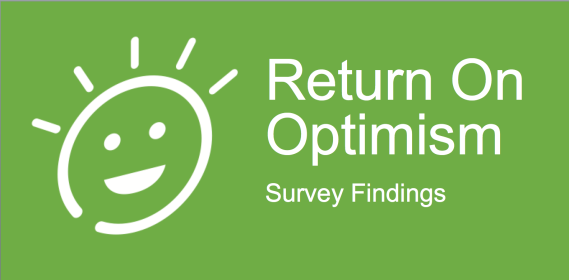Optimism is the belief that you can overcome big challenges, feel confident about your outlook, and know that what you do makes a difference. In today’s increasingly demanding, always-on workplace, optimism matters because it fuels determination, innovation and ultimately business success. So we measured it.
Over 5,000 people took part in the Return on Optimism Survey that asked people about their work environment, communications, empowerment, and more. So was the glass half full or half empty in today’s modern workplace?
The Return on Optimism Survey revealed that high levels of optimism are yet to be realized. Optimism scores across industries received a C+ grade. Healthcare and Higher Education industries showed more signs of optimism than Enterprise/Business and Government. Within Government specifically, those working in Federal Government were the least optimistic. And when it came to job function, IT was the most pessimistic department overall.
The most pressing issues that employees struggled with included:
- Time Constraints: Not being able to devote enough time to real forward thinking within Business/Enterprise.
- Uninspiring Workspaces: Work environments across industries stunting innovation and creativity.
- Breaking Eggs: A general discomfort in taking risks and failing fast.
Without optimism, innovation and success can remain out of reach for many organizations. Yet the modern workplace has evolved in a way that can conflict with inspired, forward thinking. So what can your organization do to help support an environment that gives employees a true sense of purpose? Here are some ideas.
Innovate and Fail Fast
Savvy Business 3.0 organizations are embracing the trend towards failing fast at low cost as a method of stimulating real-time learning and visioneering. To do this successfully, employees need to be able to communicate in real time, have all-encompassing access to information, intelligently filter this information and then apply context in order to arrive at new creative solutions.
Unfortunately, researchers from an HBR study were dismayed at how few modern organizations were able to sustain highly productive, creative performance amongst employees long term. The study found that innovation and creativity starts by giving workers something meaningful to accomplish, during which even small wins or minor setbacks can have a powerful influence. This needs to include sufficient management support and importantly, the time and resources needed to learn and create(1).
The Mobility Dance
The mobile employee is no longer just a trend; it’s the norm. Three years ago, a Forrester report found that two-thirds of employees within North America and Europe had the option to work remotely; building on the belief that such flexibility contributes to employee well-being(2). In addition to reducing operating expense, a recent HBR study found that mobile workers are more productive and produce higher quality work than those who have no option but to work from a corporate office. It also widens the talent pool and lowers attrition, as JetBlue found(3).
Despite this new way of work, few organizations have the right processes and policies in place to support a truly mobile infrastructure. Mobile workers are at a disadvantage if they don’t have easy and secure access to the information they need, when they need it.
Multitasking Our Way to Disengagement
Multitasking was once touted as a skill to hone for personal productivity. However, recent research has indicated a much different perspective. A Gallup study found that employees were more satisfied and productive when they could focus on their most important tasks. In fact, the most engaged teams delivered much higher profitability and higher customer satisfaction ratings compared to those who were spread thinly across tasks(4).
The multitude of mobile devices we keep isn’t helping this cause. Rather they are making it easier than ever for employees to juggle more projects. A recent NY Times article warned about how digital technology opens up the information floodgates in a way that employees feel compelled to read and respond to requests, all hours of the day and night(5). This becomes a problem as employees become even more distracted, disengaged and less capable of innovation.
A Move Towards Optimism
The time for organizations to get it right is now. The global marketplace is demanding workers who are versatile, creative, responsive and articulate. To get the best from them, organizations have to build support systems that free employees from the tyranny of unfocused, substandard, disengaging productivity. Additionally they must be given the tools, time and space for contextual, innovative creativity in order to raise employee optimism and make big things happen.
Interested in seeing where your industry scored on the optimism scale? Check out these SlideShares for a detailed breakdown of results. Choose general business results or versions for government, healthcare and higher ed versions.
References
1. Amabile, T. & Kramer, S. – (2011) – The Progress Principle: Using Small Wins to Foster Engagement and High Performance at Work – Harvard Business Review Press.
2. Forrester Report – (January, 2012) – Framing the Business and IT Impact Of Mobile And Remote Work – https://www.forrester.com/Framing+The+Business+And+IT+Impact+Of+Mobile+And+Remote+Work/fulltext/-/E-res61104
3. Bloom, N. – (January, 2014) – To Raise Productivity, Let More Employees Work from Home –https://hbr.org/2014/01/to-raise-productivity-let-more-employees-work-from-home – Harvard Business Review.
4. Gallup – (2013) – State of the American Workplace – http://www.gallup.com/services/178514/state-american-workplace.aspx
5. Schwartz, T. & Porath, C. – (May, 2014) – Why You Hate Work – http://www.nytimes.com/2014/06/01/opinion/sunday/why-you-hate-work.html – New York Times.


I work on the Uxbridge Campus, UK, It would appear to me that flexible working practices such as working from home is not available to all employees. There are some true virtual teams where teams rarely physically meet and work across geographies and time zones. However, there are business units where working from home is only permitted when it is absolutely necessary e.g. child care issues, waiting for a delivery.